

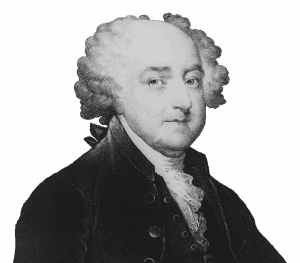
At left, John Adams from the collection of Famous Clip Art.
The friendship of Jonathan Sewall and John Adams is chronicled in David McCullough's "John Adams." Both men had been educated at Harvard University. Jonathan Sewall was one of John Adams' closest friends.
According to David McCullough, Pulitzer Prize-winning author of "Truman," Esther Quincy and Jonathan Sewall suddenly burst into the room where John Adams was about to propose to Hannah Quincy. "The moment passed, never to be recovered."
John Adams' diary is available on-line, as a transcription and as images. In his own hand, you can see where he wrote:
See: John Adams diary 3, 1759 [electronic edition]. Adams Family Papers: An Electronic Archive. Massachusetts Historical Society. http://www.masshist.org/digitaladams/
Fifteen years later, in July of 1774, John Adams and Jonathan Sewell climbed a hill in Portland, Maine overlooking Casco Bay during a break from court. Adams had been chosen by the legislature as one of five delegates to the First Continental Congress at Philadelphia. Sewell was attorney general of the Province of Massachusetts. Sewell pleaded with Adams not to attend the Congress.
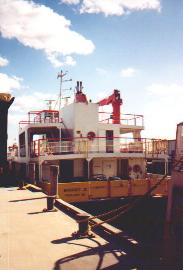
At right, the Casco Bay mailboat plies the waters beneath the hill where John Adams and Jonathan Sewell argued in July of 1774.
The following is McCullough's description of that fateful moment:
"As long as they lived, neither man would forget the moment. Adams told Sewall he knew Great Britain was "determined on her system," but "That very determination, determined me on mine." The die was cast, Adams said, "Swim or sink, live or die, survive or perish, [I am] with my country...You may depend on it.""
A more familiar variation of this quote was used by Daniel Webster in his Aug. 2, 1826 Congressional eulogy, "Eulogy of Adams and Jefferson:" "Sink or swim, live or die, survive or perish, I give my hand and my heart to this vote." President Adams and Jefferson both died on the same day, July 4th, Independence Day.
In the interveaning years, John Adams had rejected an offer of royal appointment. "...Jonathan Sewall, who had become attorney general of the province, called on Adams at the request of governor Francis Bernard to offer him the office of advocate general in the Court of Admiralty, a plum for an ambitious lawyer, Adams had no difficulty saying no."
Of this event, John Adams wrote:
Although this Offer was unexpected to me, I was in an instant prepared for an Answer. The Office was lucrative in itself, and a sure introduction to the most profitable Business in the Province: and what was of more consequence still, it was a first Step in the Ladder of Royal Favour and promotion. But I had long weighed this Subject in my own Mind. For seven Years I had been solicited by some of my friends and Relations, as well as others, and Offers had been made me by Persons who had Influence, to apply to the Governor or to the Lieutenant Governor, to procure me a Commission for the Peace. Such an Officer was wanted in the Country where I had lived and it would have been of very considerable Advantage to me. But I had always rejected these proposals, on Account of the unsettled State of the Country, and my Scruples about laying myself under any restraints, or Obligations of Gratitude to the Government for any of their favours. The new Statutes had been passed in Parliament laying Duties on Glass, Paint &c, and a Board of Commissioners of the Revenue was expected, which must excite a great fermentation in the Country, of the Consequences of which I could see no End.
My Answer to Mr. Sewall was very prompt, that I was sensible of the honor done me by the Governor: but must be excused from Accepting his Offer. Mr. Sewall enquired why, what was my Objection. I answered that he knew very well my political Principles, the System I had adopted and the Connections and Friendships I had formed in Consequence of them: He also knew that the British Government, including the King, his Ministers and Parliament, apparently supported by a great Majority of the Nation, were persevereing in a System, wholly inconsistent with all my Ideas of Right, Justice and Policy, and therefore I could not place myself in a Situation in which my Duty and my Inclination would be so much at Variance. To this Mr. Sewall returned that he was instructed by the Governor to say that he knew my political Sentiments very well: but they should be no Objection with him. I should be at full Liberty to entertain my own Opinions, which he did not wish to influence by this office. He had offered it to me, merely because he believed I was the best qualified for it and because he relied on my Integrity. I replied This was going as far in the generosity and Liberality of his sentiments as the Governor could go or as I could desire, if I could Accept the Office: but that I knew it would lay me under restraints and Obligations that I could not submit to and therefore I could not in honor or Conscience Accept it.
Mr. Sewall paused, and then resuming the Subject asked, why are you so quick, and sudden in your determination? You had better take it into consideration, and give me an Answer at some future day. I told him my Answer had been ready because my mind was clear and my determination decided and unalterable. That my Advice would be that Mr. Fitch should be appointed, to whose Views the Office would be perfectly agreable. Mr. Sewal said he should certainly give me time to think of it: I said that time would produce no change and he had better make his report immediately. We parted, and about three Weeks afterwards he came to me again and hoped I had thought more favourably on the Subject: that the Governor had sent for him and told him the public Business suffered and the office must be filled."
"In his preface to the Novanglus in the Works of John Adams, Mr. Adams characterizes his friend professionally, as follows: "Mr. Sewall had a soft, smooth, insinuating eloquence, which gliding imperceptively into the minds of a jury, gave him as much power over that tribunal as any lawyer ought to posess. He was also capable of discussing before the court any intricate question of law, which gave him at least as much influence there as was consistent with an impartial administration of justice. He was a gentleman and a scholar, had a fond of wit, humor and satire, which he used with great discretion at the bar, but poured out with unbounded profusion in newspapers.""
In a letter from John Adams to Abigail Adams of March 17, 1776, he wrote:
When John Adams was America's minister to the Court of St. James, he hunted up Jonathan Sewell. It was to be their final reunion. "...[Adams] would forever think of Sewall as one of the casualties of the [Revolutionary] war. According to Adams, when Sewall died in New Brunswick a number of years later, it was of a broken heart."
""Adams has a heart formed for friendship, and susceptible of its finest feelings," declared the loyalist Jonathan Sewall, who was highly gratified by the hearty greeting which Adams gave him in London after the Revolutionary War."

At left, the skyline of Saint John, formerly known as Carleton and Saint John, is shown. This is the harbour that the Sewells sailed into at the end of their exile from North America. The left arrow points to the location of Jonathan Sewall's New Brunswick home. The right arrow points to the location of Ward Chipman's home.
It would appear that Jonathan Sewell sailed to Saint John with another infamous former American colonist, Benedict Arnold.
From vol. 53, the March 1963 edition of the Atlantic Advocate:
See: Benedict Arnold in New Brunswick - A Collection Of Articles And Essays. Canada Summer Works Grant, Material Gathered by N. Schell, M. Gormley, and S. Dimock. 1983. 971.024/Arn at the Saint John Free Public Library.
In an ironic twist, Jonathan Sewell's son would marry Henrietta Smith, grandson of William Smith I, father of Joshua Hett Smith. "Joshua Hett Smith...married 1st Elizabeth Gordon and 2nd Ann Midleyon. Joshua Hett Smith appears to be the first to spell the name "Hett". He was an accomplice of Benedict Arnold who spent the night of September 22, 1780 at Smith’s house. Joshua Hett Smith was subsequently tried by a military court for his connection with the affair, and was acquitted, but taken into custody by the civil authorities and committed to jail. After several months’ imprisonment he escaped in woman’s dress and made his way to New York, where he was protected by the loyal population. He went to England at the close of the war, but subsequently returned to the United States."
It would appear that Jonathan Sewell's sister died while he was in England. In a "Letter from Ward Chipman to Edward Winslow, June 6, 1784," Ward Chipman wrote:
"I have just received a letter from Judge Sewell in which he informs me of the death of his Sister, Aunt Jenny, as we us'd to call her, — it is a circumstance not greatly to be regretted as her mind was impaird to a great degree, she was a good woman & I believe is gone to Heaven."
The life of Jonathan Sewell's son is as fascinating as that of his father's. Click here for Jonathan Sewell Jr.'s story.
That last line of McCullough's description of the final reunion between Jonathan Sewell and John Adams embarked me on an Internet voyage of discovery.
http://www3.sympatico.ca/robert.sewell/sewell.html#gen7
http://www3.sympatico.ca/robert.sewell/sewallfamily.html
http://www.geocities.com/Heartland/Ranch/6378/

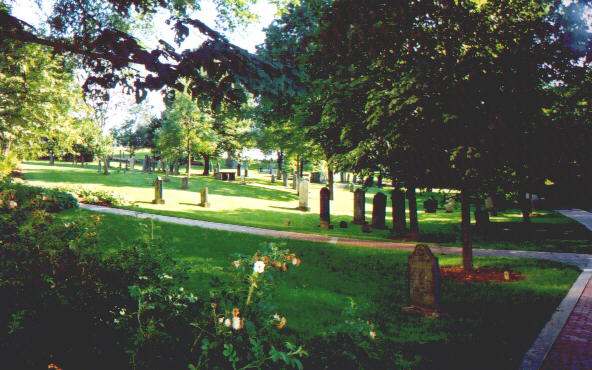
At left, Saint John's Loyalist Burial Grounds is shown.
Jonathan Sewall/Sewell, the Loyalist, was the last Royal Attorney General for the Colony of Massachusetts. He was exiled from the American Colonies to England in 1775. Jonathan Sewell and his wife Esther Quincy eventually settled in Saint John (It was spelled as St. John then.), New Brunswick. "They changed the spelling of their name to Sewell while “visiting”, i.e., in exile, in England."
It 1883, J. W. Lawrence in Footprints; or Incidents in Early History of New Brunswick that "Mrs. Sewell was a sister of the wife of John Hancock, the first signer of Independence. Mr. Sewell died at St. John, 1796, at the age of 68 years."
Esther Quincy was related by marriage to John Adams, the second President of the United Sates of America and father of John Quincy Adams, the sixth President of the United States.
http://www3.sympatico.ca/robert.sewell/quincy.html
According to this Web site, Esther Quincy was a member of the 22nd known generation of the Quincy family. Daniel Quincy, whose great X2 grandson was John Quincy Adams, was the son of Col. Edmund Quincy, a member of the 19th known generation of the Quincy family.
At left, sunset over Cambridge and the Charles River as seen from Fiedler Dock on the Esplanade in Boston.
"Esther Quincy married Jonathan Sewall, the last attorney general of the Province of Massachusetts before the American Revolution. The Sewall family home in Cambridge, Massachusetts was wrecked by a revolutionary mob, consisting of some fifty men and boys, on September 1, 1774. Jonathan was in Boston at the time, and a very frightened Esther struck a bargain with the mob of “patriots”. She exchanged the contents of her husband's wine cellar for the mob's dispersal. This terrifying event had a life-long impact on the eight-year-old Jonathan, Jr. who was to become the Chief Justice of Quebec.
Jonathan, Esther and their children Jonathan, Jr., Elizabeth and Stephen moved to Boston within a week of the sacking of their Cambridge home; and were forced to flee what was to become the United States in 1775, never to return. They changed the spelling of our name from “Sewall” to “Sewell”.
Born: November 27, 1738
Died: June 21, 1810
Married: January 21, 1764 to {Attorney General} Jonathan Sewall / Sewell."
As Attorney-General of Massachusetts, Jonathan Sewall commenced a significant legal suit in American legal history.
http://freepages.genealogy.rootsweb.com/~walkersj/lechmere.htm
- and -
http://freepages.genealogy.rootsweb.com/~walkersj/lechmere.htm
"1769; A suit was commenced against Judge Lechmere by Jonathan Sewall, Attorney-General of Massachusetts in favor of a negro demanding his freedom. The suit was terminated in favor of the negro. This is said to be the first case in which the question was settled abolishing slavery in that state. (200 Years Ago, or, A Brief History of Cambridgeport and East Cambridge.)"
There are conflicting stories about the death of Jonathan Sewall.
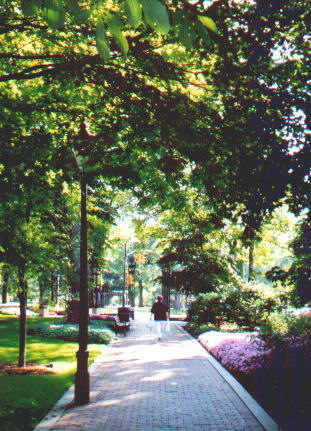
At right, a walkway in Saint John's Loyalist Burial Ground.
http://www.usigs.org/library/books/me/Portland1865/Portland022.htm
"3 Mr. Sewall succeeded Mr. Gridley as attorney general in 1.767 ; he graduated at Harvard College in 1748, but did not enter upon practice until 1757, having in the mean time kept a school in Salem. At the commencement of the difficulties with the mother country, he was caressed over to the royal party and a new office, the "King's solicitor," was created expressly for him. Ile was a good lawyer and advocate, and had a fund of wit and satire always at command, which he employed at the bar and in political controversy. He maintained a discussion in the papers in 1774 and 1775 under the name of Massachusettensis with John Adams, in which the principal subjects of disagreement with Great Britain were ably handled. He retired to England in 1775 and settled in Bristol. He died at Halifax, 1796, aged sixty-two years. The authorship of Massachusettensis has been recently denied him and given to Daniel Leonard. See Historical and Gen. Reg. pp. 18, 291, and Sabine's Loyalists, 2d edition.
4 Mr. Adams attended the court here twelve successive years prior to the revolution, and boarded with Jonathan Webb. Jonathan Sewall and Mr. Adams were intimate friends until the crisis in American politics took place. Finding they could not change each others views, they determined not to discuss the subject any more. This resolution was taken in this town when the court was sitting in July, 1774 ; they were walking upon Munjoy's hill before breakfast and earnestly discussing the great questions which were then agitating the country. The conversation terminated by Mr. Adams saying, "I see we must part; and with a bleeding heart I say it, I fear forever; but you may depend upon it, that this adieu is the sharpest thorn on which I ever set my foot." After their parting here, they did not meet again until Mr. Adams called upon him in London; in 1788, as the ambassador of the free American States."
http://www.geocities.com/rexanna_keats/maine.html
Visit Munjoy's Hill and sail on Casco Bay during your visit to Portland in Maine.

At left, the monument to loyalists buried in Saint John's Loyalist Burial Grounds is shown.
A web page of, Robert Sewell, a descendant of Jonathan Sewall, appears to confirm David McCullough's claim about Jonathan Sewall's death. It bears a picture of a plaque in memory of Jonathan Sewall (II) at Trinity Church, St. John, N.B..
http://robertsewell.tripod.com/jonsewallii.htm
http://www.trinitysj.com/
The plaque confirms that Jonathan Sewell died in 1796 and Esther Sewell died in 1810 in Montreal, Quebec.
On another page at Robert Sewell's Web site, it is written:
"He resided chiefly in Bristol till 1788, for the education of his children, then he removed to St. John’s, N. B., having been appointed Judge of Admiralty for Nova Scotia and New Brunswick. He immediately entered upon the duties of his office, which he held till his death, which occurred September 26, 1796, at the age of sixty-eight. His widow survived him, and removed to Montreal, where she died January 21, 1810.
The plaque also says that Jonathan Sewall died in Saint John and that he was interred in Judge Putnam's vault.
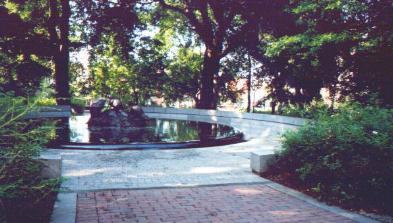
At right, the beautiful fountain in Saint John's Loyalis Burial Grounds.
According to the following Web page, Judge Putnam's vault is in the Loyalist Burial Ground in Saint John, New Brunswick.
http://www.virtualtourist.com/m/tt/21f7/
The Loyalist Burial Grounds is a Saint John landmark.
http://www.tourismsaintjohn.com/files/fuse.cfm?section=11&screen=79
http://www.saintjohn.nbcc.nb.ca/Tourism/LoyalistBurialGround/

At left, the tip of Carelton's, now known as Saint John's, Blue Rock Hill. "Geologists claim Blue Rock was once a part of Africa that became separated due to continental drift." Blue Rock Hill overlooks the land surrounding Sewell House.
There is documentary evidence that Jonathan Sewall had know James Putnam since 1758, at least. Johnathan John Adams' diary is available on-line, as a transcription and as images. In his own hand, you can see where he wrote:
See: John Adams diary 2, 5 October 1758 - 9 April 1759 [electronic edition]. Adams Family Papers: An Electronic Archive. Massachusetts Historical Society. http://www.masshist.org/digitaladams/
The story of Judge Putnam, John Adams' former teacher, is as fascinating as that of Jonathan Sewell.
http://robertsewell.tripod.com/loyalmass.htm
There is a great deal of information about the homes of Jonathan Sewell on the Internet.
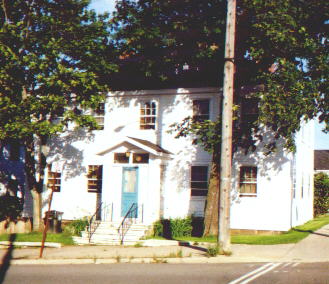
At left, the Saint John, formerly known as Carleton, home of the Sewell's is shown.
There is a Sewall House in Saint John, New Brunswick.
"24. SEWELL HOUSE
On Duke Street at Ludlow is Saint John's oldest wooden building, the Georgian-style Sewell House. It is thought to have been built for Jonathan Sewell Jr., former Attorney General of Massachusetts, who arrived in 1786 with the Loyalist settlers. He stayed in Saint John only a short time before moving to Lower Canada. Sewell House was a fine structure for the era, and had eight large rooms with servants' quarters in the attic."
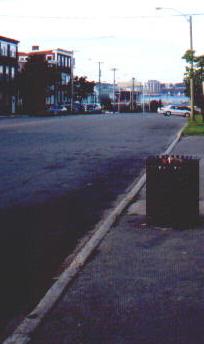
At right, the skyline of Saint John, formerly known as St. John and Carelton, is shown from King St. West in Carleton. It is unlikely that Jonathan Sewell, Jr., the law student, would have had the time and resources to build Sewell House, let alone have chosen to commute to St. John from Carelton.
Author's Notes:
Jonathan Sewell Sr., Jonathan Sewell Jr.'s father, was the former Attorney General of Massachusetts. Jonathan Sewell Sr. is Jonathan Sewell II, which only adds to the confusion.
Between 1991-1992, I lived on Blue Rock Hill which overlooks the Sewell House. My bus went by it every day. I, like most Saint Johners, was totally unaware of its history.
The Sewell House has oft been confused with Gabriel F. Ludlow's home. In Pioneer Profiles of New Brunswick Settlers by Charlotte Gourlay Robinson there is a picture of Sewell House labelled as "The Ludlow House (Old Goverment House) on Ludlow Street, Saint John. On June 24, 1965, the Telegraph-Journal reported that "...The West Side Association...reported that 180-182 Duke Street West is the original home of Gabriel G. Ludlow who became the first Mayor of Saint John."
There is a picture of Gabriel G. Ludlow's home in "Saint John and Its Neighbors," co-authored by David Goss and Fred Miller. The caption reads, as follows, "When the Loyalists arived in Saint John Gabriel C. Ludlow was appointed as mayor. He had this home built on Duke Street on the site of the gardens of a former French settlement. Mr. Ludlow's house was torn down in the late 1880s, but his grave is still within a block of the house on Courtenay Hill. (New Brunswick Museum.)"
There is a picture of Jonathan Sewell's home in "Saint John and Its Neighbors," co-authored by David Goss and Fred Miller, too. The caption reads, "The 1791 Sewell House that still stands on Duke Street at Ludlow is just a block to the east of the site of the Ludlow house. A four-apartment seniors' home today, it is little changed outside and claims to be the oldest house in Saint John. (New Brunswick Museum.)"
The City of Saint John originally consisted of the central peninsula (Parrtown) and the lower, west side of the harbour (Carleton). See: Heritage Strategy Overview Study, Central Peninsula: Saint John, new Brunswick.
I believe it is more likely to have been built for Jonathan Sewell, Sr.. The first leg of Jonathan Sewell, Jr.'s voyage from England to was noted in letters from Edward Winslow to Ward Chipman. According to a "Letter from Edward Winslow to Ward Chipman, April 11, 1785, Halifax," he arrived on board the John & Ann. In a "Letter from Edward Winslow to Ward Chipman, April 29, 1785, Halifax," EDward Winslow wrote:
"On the 25.th ins.t arriv,d The John & Ann With Sproule & his family — M.rs & Miss Putnam. Bliss & Young Sewell,..."
Sometime thereafter, Young Sewell arrived in Saint John as a student of Ward Chipman.
"Shortly after Jonathan's Sewell's admission to the Bar of New Brunswick, he removed to Quebec...." This was prior to July 7, 1792, the date of a letter from Jonathan Sewell, Jr. to Ward Chipman. (Acadiensis, Vol. VI, No. 4, October 1906.) "Stephen Sewell also studied with Ward Chipman, and after his admission as an attorney went to Qubec to join his brother, Jonathan,...." This was prior to November 21, 1791, the date of a letter from Stephen Sewell to Ward Chipman. (Acadiensis, Vol. VI, No. 4, October 1906.) Elsewhere, it was written that Jonathan Sewell, Sr.'s, family was reunited in Saint John. Therefore, Jonathan Sewell, Sr., arrived in Saint John between 1785 and 1791. (Acadiensis, Vol. VI, No. 4, October 1906.) On another page at Robert Sewell's Web site, it is written:
"He resided chiefly in Bristol till 1788, for the education of his children, then he removed to St. John’s, N. B., having been appointed Judge of Admiralty for Nova Scotia and New Brunswick...."
In vol. 53, the March 1963 edition of the Atlantic Advocate, a more precise date for the arrival of Jonathan Sewell is given:
See: Benedict Arnold in New Brunswick - A Collection Of Articles And Essays. Canada Summer Works Grant, Material Gathered by N. Schell, M. Gormley, and S. Dimock. 1983. 971.024/Arn at the Saint John Free Public Library.
In "A Heritage Now: Saint John," written by Wayne Harrison and Ross Leavitt and illustrated by celebrated Saint John artist Ray Butler, it is written, "In its almost original condition, Sewall House stands as it did when it was built before or in the early 1790's...." (Harrison, Wayne, and Leavitt, Ross. "A Heritage Now: Saint John." Saint John, N.B.: The Tyson Corporation, 1984.) the sign on the front of the house is ambiguous. It reads, as follows:
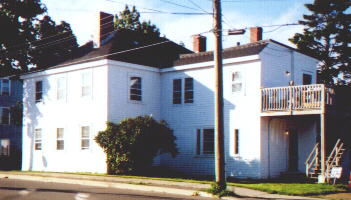
At left, the Saint John, formerly known as Carleton, home of the Sewells is shown.
"SEWELL HOUSE
CONSIDERED THE OLDEST WOODEN STRUCTURE
STANDING IN SAINT JOHN, SEWELL HOUSE
WAS BUILT IN 1791 BY LOYALIST JONATHAN
SEWELL. IT RETAINS ITS BASIC EXTERIOR
SHAPE TO THIS DAY THOUGH IT NOW HAS 4
COMFORTABLE APARTMENTS.
THIS PLAQUE PLACED BY THE WEST SIDE
COMMUNITY DAYS COMMITTEE, SEPTEMBER 23, 1988
DONATED BY R.C. LEGION, BRANCH #2"

Above, the skyline of Saint John, formerly known as Carleton and Saint John, is shown. Imagine sending your teenage son on a trip across the ocean on a sailing trip with a chaperone. This is the harbour that the Sewells sailed into at the end of their exile from North America.
The late A. H. Wetmore, noted as an authority on local historical sites, collected historical material on he Sewell House in 1935. In "Saint John's Old and Historic Buildings: A Paper Read Before the Fortnightly Club by A. H. Wetmore, October 15, 1934," he wrote:
"[Jonathan Sewell Sr. and Jonathan Sewell Jr.] drew lots 231, 232, and 252, which are on Guilford and Winslow streets at and near Lancaster street on the West side of the harbour. These lots do not seem to have been used by them but apparently they decided to build nearer to the harbour, as on the south-east corner of Duke and Ludlow streets there stands a splendid structure which has long been known as "The Old Sewell House"....
It is a large square building with four-pitch roof, "nosed" siding, a beautiful door with fan-light, and iron-frame side lights; just such as were being used 130 to 150 years ago. The house is heavily timbered and in good state of preservation. No material changes have been made on the outside of the main house but a large ell has been added and the front door is covered with a modern porch.
This is probably the oldest house in the community that has been retained in its original form and next in age to the Hazen House on Simonds street, under any conditions.
It passed from the Sewells through undetermined channels until it comes into the memory of people presently living as the property of a family by the nmae of Strange. The late Rankine Bedell, a lawyer, remembered by many of us, became the owner of it through the death of his wife, who was a Miss Strange. It is now owned and occupied by William Steen who is much interested in its history."
Above, from left to right, Helen Kottas, Charlie Kottas, Margie Keats, and Harvey Keats during a Christmas season, likely in the 1970's. Charlie taught me how to play chess and he gave me my first bike. Helen gave me his chess computer and chess books when he passed away. The author did not know her childhood friends had a connection to the house until several years after she read David McCullough's book.
In the same book, on page 103, there is a newspaper article entitled "House Built About 1790?" It was published the week after Merritt House was opened to the public, around 1960?. In it, it was written:
"Mrs. William Steen, the present owner of the house at 148 Duke Street, received a number of queries from West Side residents asking if her house was older thn the Merritt House.
...
Mrs. Charles Kottas, Mrs. Steen's daughter, said that the main body of the house itself has not been changed since Mr. Wetmore's study.
...
The house came into the possession of the late William Steen in 1929."
A final residence of Jonathan Sewell's has a fascinating history. It's history is at the following Web page:
http://www.maineantiquedigest.com/articles/cham397.htm
-and

Adams prophecy that `[Independence Day] ought to be solemnized with pomp and parade, with shows, games, guns, bells, bonfires, and illumination, from one end of this continent to the other, from this time forward forevermore' comes true in Boston every fourth of July. At left, the Morman Tabernacle Choir in performance at the Boston Pops Fireworks Spectacular.
http://www.geocities.com/khogenson2484/csp04.html
"...Occupied by Jonathan Sewall at the close of the Revolution, having been the headquarters of General Washington and his aids-de-camp from 7/2/1775 (Mrs. Washington arriving Monday, 12/11/1775) until the evacuation of Boston in April 1776...."
"...Washington was already in command of the Continental Army and had received in this house Benjamin Franklin, Benedict Arnold, and others associated with the Revolution; it is quite possible that the decision to formally break with Great Britain was made here."
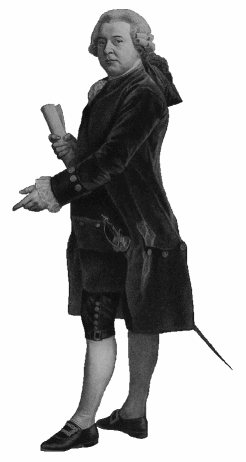
At right, John Adams from the collection of Famous Clip Art.
Life at the Sewell home is described on the following Web Page:
http://www.google.ca/search?q=cache:RXA-JoK4iEAJ:freepages.history.rootsweb.com/~amxroads/Signers/Quincy.doc+Lechmere+Sewall&hl=en&ie=UTF-8
"...But [Mary Quincy] father’s youngersister Esther, who had married Jona-than Sewall in 1763, was always readyto welcome her to her pleasant homein Cambridge, at the Lechmere house,then stan(ling under the stately lindenswhich still (listmgtlish the corner ofBrattle and Sparks Streets.~ The daughters of Edmund Quincywere all “remarkable for their beauty,”and Esther was also distinguished forher “vivacity and spirit.” Her hus-band was the intimate friend of JohnAdams, “who called him his Jonathanand wished his own name had been David.” He says of him: “He wasa gentleman and a scholar, and had afund of wit, humor and satire.” Hecalls their separation “heart-breaking,”when Sewall persisted in his allegianceto the mother country. Judge Sew~llhad his windows broken by the moband was obliged to escape to Halifaxand thence to England. In this attractive family MaryQ nincy was a frequent visitor...."
Jonathan Sewell's former residence is better know as Longfellow National Historic Site.
http://www.nationalparks.com/longfellow_national_historic_site.htm
Longfellow National Historic Site is an outstanding example of a historic site representing the themes of arts and literature. For almost half a century (1837-1882) this was the home of one of the world's foremost poets, scholars and educators, Henry Wadsworth Longfellow. Longfellow House is also significant in America's colonial history. General George Washington, Commander-in-Chief of the newly-formed Continental Army, headquartered and planned the Siege of Boston here between July, 1775 and April, 1776.
http://www.geocities.com/rexanna_keats/boston.html
Visit Longfellow National Historic Site during your visit to Boston.
http://www.geocities.com/rexanna_keats/maine.html
-and
http://eir.library.utoronto.ca/rpo/display/poem1335.html
Visit Munjoy's Hill and sail on Casco Bay during your visit to Portland in Maine.
"...`During one of his visits to Portland in 1846, Mr. Longfellow relates how he took a long walk round Munjoy's hill and down to the old Fort Lawrence. `I lay down,' he says, `in one of the embrasures and listened to the lashing, lulling sound of the sea just at my feet. It was a beautiful afternoon, and the harbor was full of white sails, coming and departing. Meditated a poem on the Old Fort.'..."
Even after the deaths of Jonathan Sewell and Judge Putnam, the lives of their sons remained intertwined on account of speculation with regard to the origins of John St. Alban Sewell.
http://www.famousamericans.net/jamesputnam/
"His son, James, born in 1753; died in England in March, 1838, was graduated at Harvard in 1774, and was one of the eighteen country gentlemen that were driven to Boston, and addressed General Gage on his departure in 1775. He went to England, became a barrack-master, a member of the royal household, and an executor of the Duke of Kent."
http://www3.sympatico.ca/robert.sewell/johnstalban.html
"There has been much speculation with regard to the origins of John St. Alban Sewell. Officially, he was baptized in September of 1793 as the natural child (i.e., born without the parents having undertaken the formality of a church marriage) of Chief Justice Jonathan Sewell and Elizabeth Cornfield. It appeared for years that Elizabeth Cornfield didn’t exist and it also appeared quite likely that John St. Alban was the son of Edward Augustus Hanover, Duke of Kent and his much loved and devoted common law wife of over twenty years, Mdm. Julie St. Laurent. Thus, John St. Alban Sewell would have been a half brother of Queen Victoria, whose parents were the Duke of Kent and Princess Victoria Mary Louisa von Saxe-Coburg."

At right, Martello Tower is shown.
Carleton Martello Tower overlooks the former residence of Jonathan Sewell. Martello Tower was originally built during the War of 1812 to guard the land approaches to the city, but it was not completed until after the war.
http://www.pc.gc.ca/lhn-nhs/nb/carleton/index_e.asp
In 1809, President Madison appointed John Quincy Adams, the son of the former friend of Jonathan Sewell and future president of the United States of America, minister to St. Petersburg. He helped negotiate the Treaty of Ghent in 1814 that ended the War of 1812.
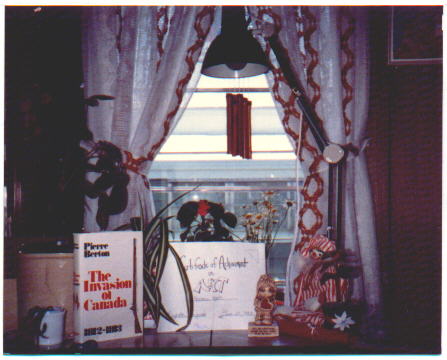
At left, I was awarded "The Invasion of Canada" by Pierre Burton, the Grade VIII Soical Studies prize from the IODE (International Daughter of the Empire), an incredible irony when you really think about it!
Carleton Martello Tower overlooks the former residence of Jonathan Sewell. Martello Tower was originally built during the War of 1812 to guard the land approaches to the city, but it was not completed until after the war.
Henry Clay was elected to the U.S. House of Representatives in 1810 and soon was chosen its speaker. As the leader of the aggressive, midwestern "War Hawks," Clay helped push President Madison into war with Great Britain in 1812. In 1814, Clay resigned from Congress after Madison chose him to be one of the American delegates to the peace conference. Henry Clay became Secretary of State to President John Quincy Adams.
-and-
Treaty of Ghent 1814 at The Avalon Project at Yale Law School
Henry Clay was my 2nd cousin, six times removed. His father, Rev. John Clay was son to John Clay, son of Henry Clay and wife Mary Mitchell; my 7th great-grandparents.
As an aside, Jonathan Sewall has connections to the current presidency. His aunt, Susanna Sewall, married Aaron Porter. He is the 2x great-grandchild of John Stanley and Susan Lancock, the 9x great-grandparents of President George Bush. They are 3rd cousins, 7x removed. Susana Sewall is also the 3x great-grandmother of Stephen GROVER CLEVELAND (1837-1908), US President, and the 3x great-grandaunt of one of my favourite authors, WILLIAM SYDNEY PORTER ("O. HENRY") (1862-1910), author.
We know snippits of the life of Jonathan Sewell from the letters of Edward Winslow. His mother's home, The Historic Winslow House in Marshfield, Massachusetts, still stands.
For further reading, see also:
"On a recent trip back in time to rural life in 19th century New Brunswick at King's Landing Historical Settlement I found myself thinking about the stories that might go with some of our more popular house plants. It seems the ones we know today as easy-to-grow, tried-and-true and persistent through all forms of neglect, are the very ones that appealed to our ancestors."
Although this parkway is not in New Brunswick, it is an example of how a region's Loyalist heritage can be capitalized upon.
Send Jeremy or Rexanna an e-mail!
Optimized for Netscape 2.0 or better. Last Updated June 10, 2003.
Copyright Rexanna M. Keats 1999, 2000, 2001, 2002, and 2003. All Rights Reserved.